 |
DEPARTMENT
RESULTS |
|
|
| |
|
Goal:
Reduce the cost of government services and products available to government
agencies through the Department of Administration |
|
Why is this goal important?
Admin must control and reduce the
cost of services and products it offers to government agencies. The
department has instituted a quarterly operational management review program
that measures achievement within each of its 14 business units. This program
aligns operational goals with the department’s mission and strategies,
leading to higher performance and improved productivity.
The majority of the department's work focuses on services that support other
state government agencies. These services include purchasing, real estate
management, infrastructure and insurance. Specialized activities include
services available from the State Demographic Center, Land Management
Information Center and the Office of the State Archaeologist.
|
|
What is Admin doing to achieve this goal?
Each of the department's business
units has implemented written operational plans that align their
responsibilities with
the department's mission of helping its customers
succeed in their specific missions. Each plan outlines the division's work,
e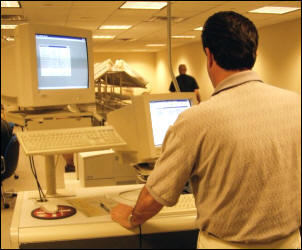 stablishes goals and defines measures for tracking achievement toward these
goals. The department overall has identified more than 30 specific areas in
which it will measure efforts toward generating savings through improved
business processes. stablishes goals and defines measures for tracking achievement toward these
goals. The department overall has identified more than 30 specific areas in
which it will measure efforts toward generating savings through improved
business processes.
The department has selected the following two measures as examples of its
overall efforts toward reducing the cost of government:
 Percent of federal mail
that is automated Percent of federal mail
that is automated
 Lease rates for
non-state-owned property Lease rates for
non-state-owned property
will not
exceed an average annual increase
of 2 percent
|
|
How is Admin’s progress?
The department’s Central Mail
business processes mail for state agencies located in the State Capitol
Complex. Automated federal mail dramatically reduces handling needs and cuts
costs through lower postage rates. The department has established a target of
automating at least 90 percent of all state agency mail, with a commensurate
target goal of achieving incremental postage savings of $150,000 for state
government agencies. In FY 2007, 93.6 percent of federal mail was automated,
saving state agencies $832,279.
The state leases more than
3.67 million square feet of office, storage and other space from private
owners throughout Minnesota at a cost to the state of nearly $57.3 million
in FY 2006. The Department of Administration is focusing on holding rental
rate increases, through negotiations, to an average increase of no more than
2 percent per year. Negotiations during FY 2007 held lease rate increases to
1.1 percent
overall, nearly 50 percent better than the target.
|
|
Goal:
Enhance customer relationships by reducing response times and increasing
customer interaction |
|
Why is this goal important?
Timely
responses by the department to requests for its services and products are
critical for improving productivity throughout the state government
enterprise. Of equal importance is assisting customers, through consultation
and collaboration, in anticipation of their product and service needs.
Reducing cycle times can result in real savings for Admin, its customers and
the state.
|
|
What is Admin doing to achieve this goal?
Many of the department's business
units have developed specific goals and measures for reducing cycle times
and increasing interaction with customers. These measures are continuously
monitored and refined to determine where process improvements can accelerate
service delivery.
The department has selected the following two examples of these measures:
 Increase in customer
satisfaction level of State Architect’s Office management of Increase in customer
satisfaction level of State Architect’s Office management of
agency
construction projects
 Increase in Materials
Management (state purchasing office) staff time dedicated to
Increase in Materials
Management (state purchasing office) staff time dedicated to
strategic sourcing activities, such
as market research, data analysis and customer
collaboration, rather
than traditional transaction processing
|
|
How is Admin’s progress?
The State Architect’s Office
(SAO) conducts in-person surveys and discussions with agencies to strengthen
its Agency Team Leader concept, identify opportunities for improvement,
provide knowledge about project management, encourage agencies to utilize
its services and to demonstrate that SAO is interested in its customers. The
target for this new measure for FY 2007 is to meet with two agencies per
quarter. In FY 2007, the State Architect’s Office met with four agencies
(the target was six) and is incorporating feedback from these sessions into
its processes.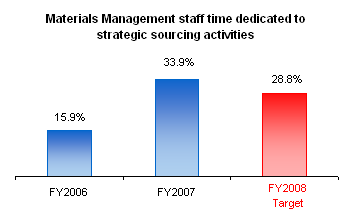
The
State of Minnesota’s Drive to Excellence strategic sourcing initiative
mandates a shift of procurement staff resources from transaction processing
to a strategic model of procurement. Beginning with the second quarter of
FY 2006, department personnel began tracking the time they are dedicating to
inter-agency teams, market research, training/mentoring customer agencies
and other strategic initiatives. Staff time spent on the new strategic
activities increased from 15.9 percent in FY 2006 to 33.9 percent in FY 2007, surpassing the
the target by more than 16 percent.
|
|
Goal:
Increase the effectiveness and efficiency of services available through the
department |
|
Why is this goal important?
The department
offers a wide variety of services and products that help state agencies and
other governmental units achieve more efficient operations. Admin ensures that
state buildings and grounds are clean, safe, comfortable and aesthetically
pleasing and that agencies receive the highest quality for the lowest
possible cost for their insurance, space, office products and vehicle needs.
The department's efforts toward enhancing service quality focus on meeting
and exceeding the requirements of its customers and, in doing so, better
serving Minnesota and its citizens.
|
|
What is Admin doing to
achieve this goal?
The department’s business units offer
a wide variety of services and products to state government and, through
cooperative programs, local governments, school districts and the higher
education community.
The department is highlighting the following
quality measures that reflect the agency's emphasis on efficiency:
 State
vehicle program
lease costs in comparison to
established cost-per-mile target rates
State
vehicle program
lease costs in comparison to
established cost-per-mile target rates
 Office Supply Connection
orders placed via web-based system, rather than fax or Office Supply Connection
orders placed via web-based system, rather than fax or
e-mail
|
|
How is Admin’s progress?
The department’s
vehicle leasing program provides passenger cars and light trucks for the
lo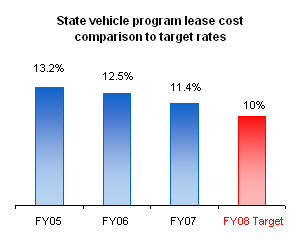 ng-term needs of state agencies, local units of government, school
districts and higher education institutions. Lease program personnel
work with customers to ensure that they select vehicles that will closely
match their business
and program needs. Newer leases include cost-per-mile
targets that, when measured against
actual
cost-per-mile, determine whether a vehicle is cost-effectively meeting the
customer’s needs. It is the goal of the department to assure that leased
vehicles are operated within 10 percent of the established target for fleet
management effectiveness. The fleet-management effectiveness rate for leased
vehicles was 11.4 percent in FY 2007, 1.3
percentage points above the 10 percent target. ng-term needs of state agencies, local units of government, school
districts and higher education institutions. Lease program personnel
work with customers to ensure that they select vehicles that will closely
match their business
and program needs. Newer leases include cost-per-mile
targets that, when measured against
actual
cost-per-mile, determine whether a vehicle is cost-effectively meeting the
customer’s needs. It is the goal of the department to assure that leased
vehicles are operated within 10 percent of the established target for fleet
management effectiveness. The fleet-management effectiveness rate for leased
vehicles was 11.4 percent in FY 2007, 1.3
percentage points above the 10 percent target.
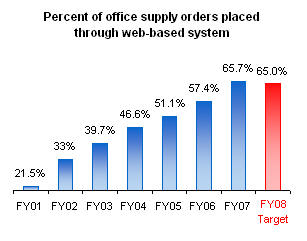 Office
Supply Connection is working to convert more of its customers' fax and e-mail orders to
a web-based ordering
system, which reduces labor-intensive handling and processing. This is
achieved through training sessions, one-on-one communication with customers
and other promotional and educational efforts. The target is to achieve
placement of 65 percent of all orders, on average, through the web-based
ordering system. An
average of 65.7
percent of orders were placed through the web-based system in FY 2007. Office
Supply Connection is working to convert more of its customers' fax and e-mail orders to
a web-based ordering
system, which reduces labor-intensive handling and processing. This is
achieved through training sessions, one-on-one communication with customers
and other promotional and educational efforts. The target is to achieve
placement of 65 percent of all orders, on average, through the web-based
ordering system. An
average of 65.7
percent of orders were placed through the web-based system in FY 2007.
|
|
Provide services and products that demonstrate state government's
commitment to effective environmental stewardship |
|
Why is this goal important?
Human activity has a huge effect
on the environment. Government can reduce its impact by enacting and
following planet-friendly policies, by using products and services that are
less harmful to the environment, and by promoting environmentally
responsible purchasing, including the use of alternative fuels such as E85
and bio-diesel. The department’s efforts toward achieving this goal include:
 Recycling, including operation
of the State Recycling Center
Recycling, including operation
of the State Recycling Center
 Increasing the use of clean
fuels, such as E85 and bio-diesel, as alternatives to petroleum products Increasing the use of clean
fuels, such as E85 and bio-diesel, as alternatives to petroleum products
 The use of sustainable design
in building construction The use of sustainable design
in building construction
 Policies and contracting
processes emphasizing the purchase of environmentally friendly products and
services Policies and contracting
processes emphasizing the purchase of environmentally friendly products and
services
 The utilization of “green”
products and services in The utilization of “green”
products and services in
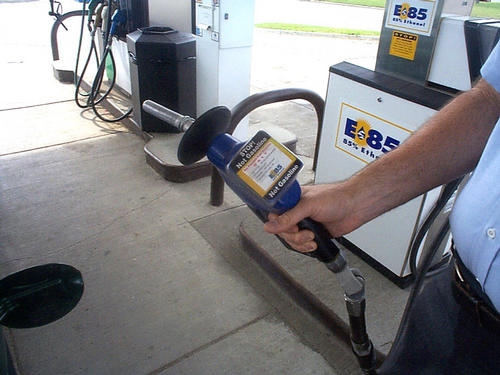 its operations, such as building and grounds
maintenance its operations, such as building and grounds
maintenance
The
department has selected the following two measures as examples of its
overall efforts toward providing services and products that demonstrate
state government’s commitment to effective environmental stewardship:
 The use of E85 fuel by the
state fleet
The use of E85 fuel by the
state fleet
 Tonnage of waste products
managed at Tonnage of waste products
managed at
the State Recycling Center
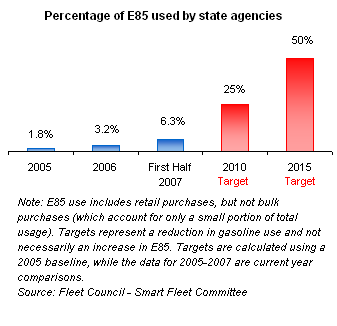 What is Admin doing to
achieve this goal? What is Admin doing to
achieve this goal?
Admin has
taken several steps that are helping expand the use of alternative fuels,
particularly E85, in state
vehicles. The department in 2005 implemented a fuel reporting and tracking
tool for collecting agency fuel purchasing information. The SmartFleet
Committee, debuting in 2006 and chaired by Admin, is implementing a fleet
management information system that helps managers enhance decision-making
regarding their agency’s vehicle needs. The committee is also working with
Admin’s procurement office to ensure that flex-fuel vehicles are included on
state contracts whenever possible, replacing less fuel-efficient models with
models that are more fuel-efficient.
The department, through its Resource Recovery
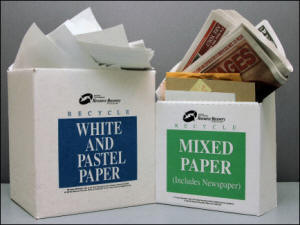 Program, assists metropolitan
state agency and regional government operations toward achieving the
statutory mandate of recycling 60 percent of their discarded materials, the
bulk of which are paper products. The metropolitan-area recycling rate was
75 percent for the 2006 fiscal year. In addition to assisting agencies and
other governmental units with reducing, recycling and reusing waste, the
department operates the State Recycling Center, located in St. Paul, which
processes materials for state agencies and other government offices located
in the metropolitan area. Program, assists metropolitan
state agency and regional government operations toward achieving the
statutory mandate of recycling 60 percent of their discarded materials, the
bulk of which are paper products. The metropolitan-area recycling rate was
75 percent for the 2006 fiscal year. In addition to assisting agencies and
other governmental units with reducing, recycling and reusing waste, the
department operates the State Recycling Center, located in St. Paul, which
processes materials for state agencies and other government offices located
in the metropolitan area.
How is Admin's
progress?
The use of E85 in the state
fleet has increased by more than 65 percent in each of the two
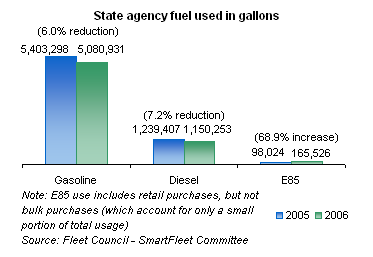 years since the Governor issued
Executive Order 04-10. E85 use by state agencies is increasing, while
gasoline use is decreasing. E85 use increased 69 percent, from 98,000
gallons in 2005 to over 165,000 gallons in 2006. Through the first six
months of 2007, E85 purchases have more than doubled from 2006 to an average
of more than 30,000 gallons per month. In addition, E85 use since March 2007
is growing by more than 5,000 gallons per month. Gasoline purchases in 2006
declined 6 percent, or 322,367 gallons, compared to 2005. years since the Governor issued
Executive Order 04-10. E85 use by state agencies is increasing, while
gasoline use is decreasing. E85 use increased 69 percent, from 98,000
gallons in 2005 to over 165,000 gallons in 2006. Through the first six
months of 2007, E85 purchases have more than doubled from 2006 to an average
of more than 30,000 gallons per month. In addition, E85 use since March 2007
is growing by more than 5,000 gallons per month. Gasoline purchases in 2006
declined 6 percent, or 322,367 gallons, compared to 2005.
|
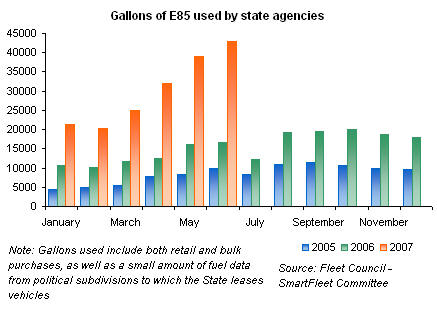
|
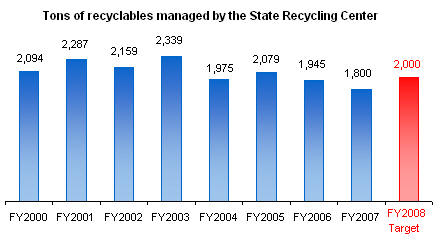 The
Recycling Center has set a target of
managing 2,000 tons of recyclables per
fiscal year, which includes collecting, sorting and processing materials for
the recyclable materials resale market.
The amount of materials handled by the center has declined over the past
three years, to 1,800 tons in FY 2007. In an effort to increase recycling, the Recycling Center
in February 2007 launched an aggressive recycling campaign – “7% in ’07”
– seeking a 7 percent increase in recycling volume over the preceding
calendar year. The
Recycling Center has set a target of
managing 2,000 tons of recyclables per
fiscal year, which includes collecting, sorting and processing materials for
the recyclable materials resale market.
The amount of materials handled by the center has declined over the past
three years, to 1,800 tons in FY 2007. In an effort to increase recycling, the Recycling Center
in February 2007 launched an aggressive recycling campaign – “7% in ’07”
– seeking a 7 percent increase in recycling volume over the preceding
calendar year.
|
|
Last update on
08/03/2007
|
|



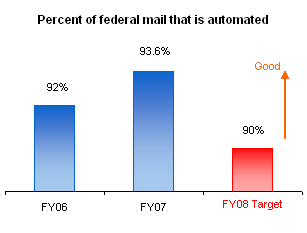
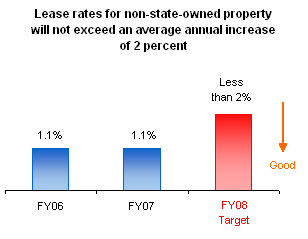
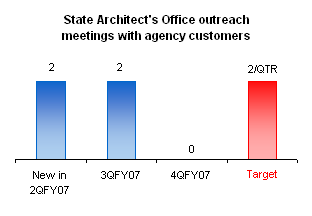


 ng-term needs of state agencies, local units of government, school
districts and higher education institutions. Lease program per
ng-term needs of state agencies, local units of government, school
districts and higher education institutions. Lease program per Office
Supply Connection is working to convert more of its customers' fax and e-mail orders to
a web-based orderin
Office
Supply Connection is working to convert more of its customers' fax and e-mail orders to
a web-based orderin

 years since the Governor issued
Executive Order 04-10. E85 use by state agencies is increasing, while
gasoline use is decreasing. E85 use increased 69 percent, from 98,000
gallons in 2005 to over 165,000 gallons in 2006. Through the first six
months of 2007, E85 purchases have more than doubled from 2006 to an average
of more than 30,000 gallons per month. In addition, E85 use since March 2007
is growing by more than 5,000 gallons per month. Gasoline purchases in 2006
declined 6 percent, or 322,367 gallons, compared to 2005.
years since the Governor issued
Executive Order 04-10. E85 use by state agencies is increasing, while
gasoline use is decreasing. E85 use increased 69 percent, from 98,000
gallons in 2005 to over 165,000 gallons in 2006. Through the first six
months of 2007, E85 purchases have more than doubled from 2006 to an average
of more than 30,000 gallons per month. In addition, E85 use since March 2007
is growing by more than 5,000 gallons per month. Gasoline purchases in 2006
declined 6 percent, or 322,367 gallons, compared to 2005.
